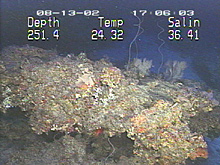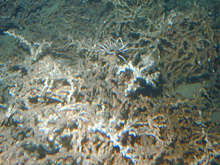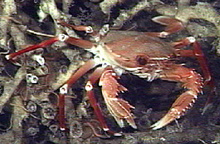
Rocky conglomerates provide the basis for the reefs on the outer continental shelf. Click image for larger view.
Diverse Invertebrates of the Deep: Coral Banks and Shelf Edge Reefs
Martha Nizinski, PhD
Zoologist
NOAA, National Marine Fisheries Service
National Systematics Laboratory
Steve Ross, PhD
North Carolina National Estuarine Research Reserve
Co-principal Investigators
The outer continental shelf and the upper continental slope provide very different habitats for invertebrates. While each habitat supports an extensive reef profile, the overall reef structures are quite different. Although the physical distance between these habitats is not great, physical structure and environmental conditions, often related to depth, vary greatly. As a result, each of these habitats is home to a distinct and diverse assemblage of invertebrates.
The Outer Shelf: A Transition Zone
On the outer shelf hard grounds (from about 90-200 meters depth), high-profile reef features provide the substrate required for hundreds of benthic (bottom-dwelling) invertebrates that live in and among the rocks. They, in turn, provide a living structure to the system. Here, soft corals, bryozoans, sponges, and other encrusting organisms reign supreme. These areas of “live bottom” are within the zone penetrated by sunlight (photic zone) and provide an oasis for many kinds of mobile invertebrates seeking shelter and food.
The more stable temperatures of this region offer a refuge for species usually thought of as tropical. Crustaceans, including swimming crabs, box crabs, squat lobsters, and rock shrimp, as well as brittle stars and gastropods, have been identified from this area. Some of these species are the same or similar to species that occur in shallower waters closer to shore. Others are the same or similar to species occurring on the continental slope. The outer shelf seems to be a transition zone between shallow-water and deep-water “reef” faunas.
Lophelia Banks: For the Specialist or the Opportunist?
We are just beginning to gain an appreciation of the invertebrate community assemblage that utilizes the Lophelia coral banks of the North Carolina upper slope (350-700 m). Such vast, three-dimensional structures, found below the photic zone, house individuals on, in, and among the Lophelia branches. This habitat, however, is very difficult to study. The complex structure of the Lophelia, deep water, and strong currents provide many challenges, the least of which is the cooperation of the animals we are trying to study. The coral matrix can be very dense; it will take some time to uncover what lies deep within the coral reef.
Large decapod (10-footed) crustaceans found on the Lophelia banks include squat lobsters (Eumunida picta) and brachyuran or true crabs. Squat lobsters look like lobsters, but are more closely related to hermit crabs. The majority of squat lobsters are found in deeper waters and have very long claws that can be twice as long as their bodies. Our observations from the submersible indicate that the squat lobster is a dominant component of the decapod assemblage associated with the Lophelia banks. Adults of this species are commonly observed perched on top of the Lophelia banks. Often, these individuals have their claws raised up high over the plane of the reef. This is an important feeding posture because one individual was observed snatching a small fish from the water column!
Other common Lophelia residents include anemones and sponges, which attach directly on coral, and several species of echinoderms (starfish, sea urchins and their relatives). One species of brittle star is so abundant that the reef looks like it has been taken over by squirming aliens! We have also observed and collected several species of shrimps around the reefs, but we are still unclear as to whether these shrimps live on the reef or adjacent to it.
As more species are identified, we will address the question of habitat affinities of the associated organisms. Scientifically speaking, are the residents associated with the Lophelia reefs obligate or facultative? In other words, do Lophelia banks harbor a unique assemblage of organisms that are always found living with Lophelia and require that habitat (obligate), or are the residents of these reefs representative of the local fauna and their association with the reef of secondary importance (facultative)?

The rubble zone is found adjacent to the reef proper. Both living and dead coral fragments are found in this area.
A spider crab (near top center) can be seen foraging through the rubble in search of food. Click image for larger view.
Rubble Zone: Coral or Sand Affinities?
In addition to the coral reef proper, a large area surrounding the living reef becomes littered with living fragments and dead coral rubble. Dead, gray coral rubble accumulates as a thick, rough carpet, forming a second type of coral-derived habitat that may extend for hundreds of meters away from the living reef mound. We often use an otter trawl to collect in these habitats. This provides a more comprehensive, wider sample area than we can obtain with submersible observations and videotapes; however, microhabitat information and species associations can not be determined using this sampling method. A diverse fauna of invertebrates is associated with the coral rubble habitat. Three different species of squat lobsters have been collected here, in addition to squat lobsters, which are also found on the reef proper. Spider crabs, box crabs, shrimps, deep-water lobsters with small, unpigmented eyes, and sea urchins are also represented in these samples.
As more species are identified, we will compare and contrast the fauna found in the rubble zone with that on the reef proper and on the surrounding sand flats. Do organisms living in the rubble zone have higher affinities with coral-dwelling organisms or with organisms living on the sand flats?
Questions and More Questions
Many of the species we are finding on the Lophelia banks and outer continental shelf were described hundreds of years ago, yet there is virtually no information available on these creatures' habits or habitat. Because of the difficulty collecting samples at these extreme depths, our knowledge of these animals is minimal. How exciting it is to see them alive and in their natural habitat! Manned submersibles and remotely operated vehicles have been particularly productive in providing a new understanding of invertebrates living on the outer shelf and upper slope. Live color, behavioral interactions, and species associations are now being observed. We have so much to learn, but as more data are collected and more animals are examined, we will gain a much better understanding of these deep-dwelling inhabitants.






















